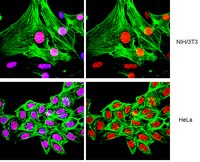Molecular mechanism underlying the differential MYF6 expression in postnatal skeletal muscle of Duroc and Pietrain breeds.
Fan H, Cinar MU, Phatsara C, Tesfaye D, Tholen E, Looft C, Schellander K.
Gene
486
8-14
2011
Show Abstract
Among modern western pigs, Duroc (high meat fat ratio) and Pietrain (low meat fat ratio) breeds extensively utilized in commercial pork production differ extremely for their muscle phenotypes. The molecular mechanism, especially the epigenetic mechanism, underlying these breed-specific differences is poorly known. Myogenic factor 6 (MYF6) is the most abundantly expressed myogenic factor in adult muscle. Moreover, MYF6 tends to be expressed more highly in muscle tissue of the lean selection line and is supposed to be one promising candidate gene for growth- and meat quality-related traits in adult pigs. Six months old female Duroc and Pietrain pure breed pigs were used in this study. Protein and mRNA levels of MYF6 in loin eye muscle were determined by Western blotting and quantitative Real-time reverse transcription PCR (qRT-PCR), respectively. The DNA methylation status of the MYF6 5'-regulatory region was determined by bisulfite sequencing PCR (BSP). The global Histone 4 acetylation at lysines 5 (H4K5) and 8 (H4K8) were examined by Western blotting. Pietrain pigs exhibited significant higher expression of MYF6 and hypermethylated E2F1 binding element within MYF6 5'-regulatory region as compared with Duroc pigs. Significant elevation in DNA methyltransferase 1 (DNMT1) expression was observed in Pietrain pigs which are in agreement with hypermethylation of MYF6. Histone acetylation level at neither H4K5 nor H4K8 is significant between two breed pigs. Nevertheless, mRNA and protein expression of E2F1 were significantly elevated in the Pietrain breed. It is thus conceivable that the upregulation of MYF6 transcription in postnatal Pietrain pigs is not associated with cis-activation by epigenetic modification of MYF6 5'-regulatory region, but may be attributed to trans-activation through enriched expression of E2F1. | 21749918
 |
A component of BRAF-HDAC complex, BHC80, is required for neonatal survival in mice.
Shigeki Iwase, Naomi Shono, Arata Honda, Tomoko Nakanishi, Shin-ichi Kashiwabara, Satoru Takahashi, Tadashi Baba
FEBS letters
580
3129-35
2006
Show Abstract
BHC80 is a component of BRAF-HDAC complex (BHC) involved in transcriptional repression of neuron-specific genes in non-neuronal cells. However, BHC80 is present in both neuronal and non-neuronal cells. To explore the physiological importance of BHC80 in vivo, and the precise mechanism underlying neuron-specific gene repression by BHC80, we have produced mutant mice lacking Bhc80. The loss of Bhc80 resulted in neonatal lethality without sucking mother's breast milk sufficiently. Although Bhc80-deficient mice showed no developmental defect in the neuronal and non-neuronal tissues, Bhc80 is indispensable for the survival of neonatal pups. | 16684532
 |










